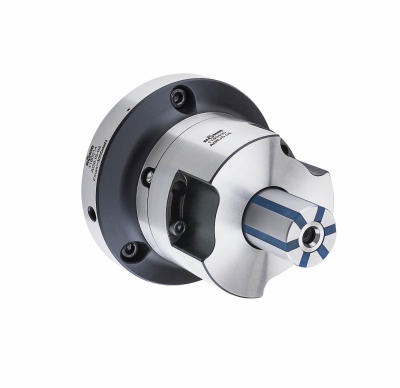
RÖHM Products of America introduced the lightweight, compact AGILIS power-operated cartridge mandrel clamping system. This new mandrel provides consistent, rigid workpiece ID clamping of small diameters for grinding, turning, milling, drilling and measuring applications.
The AGILIS’s mandrels axially draw in workpieces against a rigid workstop and hold workpieces with diameters as small as 10 mm with concentricity tolerances well within 0.01 mm. The clamping system’s sturdy design includes hardened clamping segments and guides that deliver uniform performance throughout long production runs. For flexibility, AGILIS is compatible with both 269-90 and 267-20 types of intermediate flanges.
An available manual quick-change system cuts the time needed to switch out clamping devices on the AGILIS. The quick-change system employs adapter plates to accommodate RMS quick-clamping screws. With quick-clamping screws, operators can complete manual clamping changes in approximately 30 seconds, all while maintaining positioning accuracy within 0.005 mm. The manual quick-change technology enables the use of central lubrication and airflow measurement devices.
Contact Details
Related Glossary Terms
- gang cutting ( milling)
gang cutting ( milling)
Machining with several cutters mounted on a single arbor, generally for simultaneous cutting.
- grinding
grinding
Machining operation in which material is removed from the workpiece by a powered abrasive wheel, stone, belt, paste, sheet, compound, slurry, etc. Takes various forms: surface grinding (creates flat and/or squared surfaces); cylindrical grinding (for external cylindrical and tapered shapes, fillets, undercuts, etc.); centerless grinding; chamfering; thread and form grinding; tool and cutter grinding; offhand grinding; lapping and polishing (grinding with extremely fine grits to create ultrasmooth surfaces); honing; and disc grinding.
- inner diameter ( ID)
inner diameter ( ID)
Dimension that defines the inside diameter of a cavity or hole. See OD, outer diameter.
- mandrel
mandrel
Workholder for turning that fits inside hollow workpieces. Types available include expanding, pin and threaded.
- milling
milling
Machining operation in which metal or other material is removed by applying power to a rotating cutter. In vertical milling, the cutting tool is mounted vertically on the spindle. In horizontal milling, the cutting tool is mounted horizontally, either directly on the spindle or on an arbor. Horizontal milling is further broken down into conventional milling, where the cutter rotates opposite the direction of feed, or “up” into the workpiece; and climb milling, where the cutter rotates in the direction of feed, or “down” into the workpiece. Milling operations include plane or surface milling, endmilling, facemilling, angle milling, form milling and profiling.
- turning
turning
Workpiece is held in a chuck, mounted on a face plate or secured between centers and rotated while a cutting tool, normally a single-point tool, is fed into it along its periphery or across its end or face. Takes the form of straight turning (cutting along the periphery of the workpiece); taper turning (creating a taper); step turning (turning different-size diameters on the same work); chamfering (beveling an edge or shoulder); facing (cutting on an end); turning threads (usually external but can be internal); roughing (high-volume metal removal); and finishing (final light cuts). Performed on lathes, turning centers, chucking machines, automatic screw machines and similar machines.






